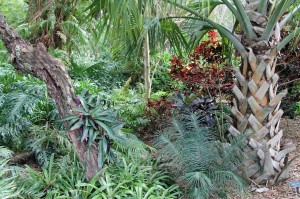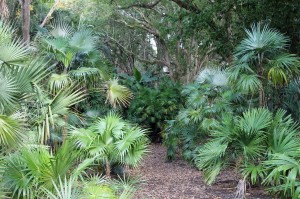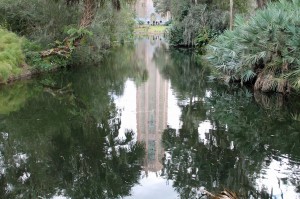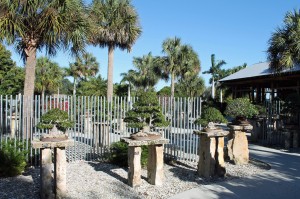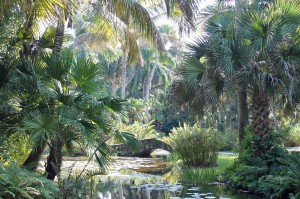Where the Plants Are Still Growing
February 4th, 2014
I’m back from a semi-snowbird getaway to central Florida, where I can report that plants are still alive.
It’s been chilly there so far this year, too – mostly days in the 60s with a few brushes with overnight frost – but certainly way better than our vortexish January.
The “balmy” weather (in northerly terms) gave my wife, Sue, and me a chance to see some of central Florida’s public gardens – all ones I’d never seen before and all different from one another.
If you favor looking to reading, check out the Central Florida Gardens Photo Gallery I just posted to go on a virtual tour. And if you’re thinking about heading down there yourself, check out the 3-bedroom, pool-equipped villa our daughter, Erin, rents just 15 minutes from Disney World.
We both ranked Sarasota’s Marie Selby Botanical Gardens as our favorite.
Set in a residential neighborhood along Sarasota Bay, this place, I think, is underrated because it sounds like a stuffy research, plant-specimen place.
Selby’s main claim to fame is its collection of epiphytes, which to most people sounds like some kind of skin-disease-causing parasite. Epiphytes actually are curious plants that survive on air and rain outside of soil. They’re commonly called “air plants.”
Selby’s air plants are fascinating, for sure, but there’s way more to this tropical 13 acres than those.
I particularly liked the “strangler fig” tree that reaches rainforest sunlight by climbing up existing trees, then over-growing and killing them. (See last week’s e-column for more on this.)
Also cool was the Bismark palm, a 20-footer with blue foliage and large vertical fans.
Sue liked the rainbow gum tree (a type of eucalyptus) for its pink and green flaking bark and Selby’s new Children’s Rainforest, a unique place for exploring among trees, huts, cliffs and a waterfall.
The gardens’ founder, Marie Selby, was an interesting woman, too. She grew up in Ohio, married a wealthy oil executive who overwintered in Sarasota, was the first woman to cross the United States in a car, and was an accomplished pianist.
Setting up this beautiful and intriguing garden wasn’t a bad legacy either.
Sue and I also both liked the Harry P. Leu Gardens in Orlando.
This one covers 50 acres and was the one-time home of Harry and Mary Jane Leu, a local garden-loving couple who donated their plant-filled estate to the city of Orlando in 1961. Leu made his money owning a construction-supply business.
The Leu Gardens are more of a theme-garden experience. The Rose Garden is particularly impressive – especially if you see it blooming in January of all times.
But there’s also eastern America’s biggest camellia collection, tons of palms and cycads, and gardens devoted to herbs, citrus, vegetables, arid plants, butterfly-attracting plants and 11 different “idea gardens.”
There’s a nice mix here, and it’s a good place to see what all will thrive in central Florida’s climate and soil.
Another superb garden is the 50-acre Bok Tower Gardens, set atop one of Florida’s few ridges (298 feet up!) and located about an hour southwest of Orlando in Lake Wales.
Bok Tower is a mostly woodland garden, filled with palms, live oaks, magnolias and the tropical vegetation that thrives in the shade under them.
The highlight is the 205-foot, marble and coquina Gothic Revival “singing tower.” It stands above the trees as high as a 20-story building and can be heard for miles when the carillon inside plays.
This sanctuary was built by Philadelphian Edward W. Bok, a Dutch immigrant who made his fortune as editor of the Ladies Home Journal in the early 1900s (also by marrying the publisher’s only daughter).
Bok wintered in Florida and was attracted to this site both by the plentiful wildlife and by the incredible sunsets seen from the top of the ridge. Birders will love this place.
Bok donated Bok Tower Gardens in 1929 as a gift to the American people for the opportunity the United States brought him. Thank you, Mr. Bok.
A fourth garden worth seeing is Heathcote Botanical Gardens along central Florida’s east coast in Fort Pierce.
Bonsai is the main draw here. Heathcote claims to have the largest publicly displayed collection of tropical bonsai plants in the United States – some 100 specimens artfully displayed on two-legged stone tables in the James J. Smith Bonsai Gallery.
The Japanese garden is also nice, and the Gardens’ most unusual plant is a three-headed sabal palm that looks like a tropical menorah in the making.
Heathcote is small – only about 5 acres – but it’s a must stop for any bonsai fan.
And while you’re down that way, check out the wonderful McKee Botanical Garden along U.S. 1 in Vero Beach.
Once 80 acres and attracting 100,000 visitors a year in the 1940s and 1950s as McKee Jungle Gardens, this place originally was known for its amazing collections of orchids and water lilies.
I-95 and Disneyworld shifts in tourism caused it to close in the 1970s. Most of it became condos, but the locals and a land trust resurrected it into 18 acres in the 1990s. It’s gorgeous.
Now it’s got strolling paths that wind you throughout all sorts of tropical vistas, most of them featuring bridges and water.
There’s a superb variety of plants here… trees, palms, bamboos, orchids, a bat-pollinated “sausage tree” with hanging fruits that look like sausages, a “sleeping tree” that’s still growing horizontally after being blown down in a storm and much, much more.
I wasn’t sure what to expect after reading the history. If this is what’s left, I can’t imagine how incredible it was at 80 acres.
All of these places are within a 2-hour’s drive of Orlando and well worth visiting if you ever get down that way. Especially in January.








